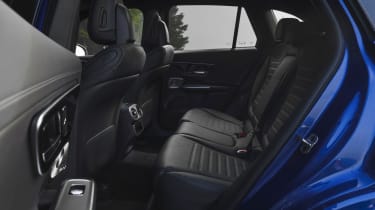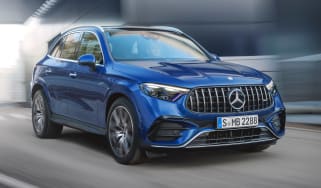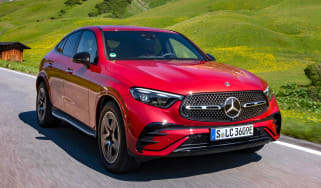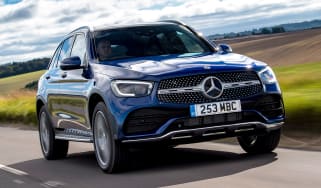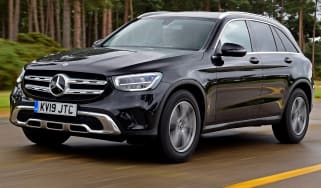Mercedes GLC review
The Mercedes GLC is a hugely impressive SUV with a fantastic interior and loads of in-car tech
The Mercedes GLC is one of the most hi-tech cars in the premium mid-size SUV class, and features a fantastic, luxurious interior that ensures it looks as good on the inside as it does on the outside. If you’re looking for a family SUV with a focus on luxury, the GLC should definitely be on your shortlist. The plug-in hybrid models are also impressively efficient, making them particularly appealing to company car buyers.
However, the Mercedes GLC simply isn’t as good to drive as rivals from BMW and Jaguar, and models on larger alloy wheels at the top of the range ride quite harshly over bumps. The GLC is far more expensive than its closest rivals, too.
About the Mercedes GLC
The Mercedes GLC is now in its third generation, although this is the second version available in the UK. It remains in the same spot in the Mercedes range – above the GLA and GLB SUVs but below the GLE and GLS in both size and price. The letters in the name also hint at its link to the C-Class saloon and estate, which was itself refreshed with similar tech and engines to the GLC.
The latest GLC doesn’t look all that different from the previous model on the outside, but the interior has had a makeover and now features the latest MBUX infotainment system using an 11.9-inch portrait touchscreen display and a 12.3-inch digital instrument cluster behind the wheel. It looks fantastic and means the GLC has one of the most modern-looking interiors around.
The engine range starts with the GLC 220 d, a 2.0-litre diesel engine with mild-hybrid tech to boost efficiency, and the GLC 300 d, a more powerful version of the same engine. There’s also a GLC 300 petrol with a 2.0-litre turbo engine. In fact, there are no GLC models in the new range that have more than four cylinders yet.
The more expensive and powerful models in the regular GLC lineup are both plug-in hybrids – great for company car drivers, who benefit a lot from the low Benefit-in-Kind tax costs on these models. There’s a petrol GLC 300 e and a diesel GLC 300 de, both using a 2.0-litre engine combined with electric motors and a 31kWh battery capable of delivering about 80 miles of pure-electric driving on a single charge.
Mercedes' AMG division has already got its hands on the latest GLC. The GLC 43 produces 415bhp from its four-pot petrol engine, while the GLC 63 S E Performance pumps out an even more generous 671bhp and 1,050Nm. The GLC 63 S is technically a plug-in hybrid, but its battery pack is directly derived from tech used by AMG’s F1 team, so the 6.1kWh unit is designed for rapid delivery and recuperation, not for lengthy journeys. Both AMG versions of the GLC are expected to arrive sometime in 2023.
It’s a similar engine lineup to the old model and like before, there’s also a GLC Coupe that features pretty much all the same equipment but with a slightly different roofline for a sportier look. The normal GLC SUV we’re reviewing here has more boot space than before, which is very welcome -–and it hasn’t come at the expense of passenger space either, so it’s still a roomy family car.
Rivals for the GLC include the BMW X3 and Jaguar F-Pace, plus the Volvo XC60 and Audi Q5. These models all have their strong points – the BMW and Jag are better to drive than the Mercedes, while the Volvo and Audi are a bit more comfortable. None have the interior luxury or tech of the Mercedes, though.
There are three trim levels for now: AMG Line, AMG Line Premium and AMG Line Premium Plus. All come with four-wheel drive, 19-inch alloys, LED lights, climate control, heated seats and twin infotainment screens with Apple CarPlay and Android Auto smartphone connectivity, plus wireless charging.
Engines, performance and drive
The Mercedes GLC uses the same platform as the C-Class saloon and estate, and so it shares engines with that model as well. Unlike the C-Class the GLC uses four-wheel drive as standard – all models come with Mercedes’ 4MATIC set-up and a nine-speed automatic gearbox.
The gearbox is smooth and shifts quickly enough – it’s a match for the units in any of its rivals and the hybrid versions’ electric motors mean they’re even more relaxing to drive as the gearbox doesn’t even have to shift at low speeds when the engine isn’t even running.
There are two versions of the GLC that have a full plug-in hybrid setup: the GLC 300e and GLC 300de. The 300e is the petrol version and it uses a 254bhp 2.0-litre petrol engine along with a 134bhp electric motor, while the 300de uses a diesel motor with 194bhp and the same electric motor.
Outside of the plug-in models, the range includes the GLC 220d (a 194bhp diesel), the GLC 300d (a 265bhp diesel) and the GLC 300 (a 254bhp petrol). There are no six-cylinder models – all are 2.0-litre four-cylinder engines and so aren’t the most luxurious-feeling motors, but they are quiet and smooth enough.
The GLC 300 has 400Nm of torque, the 300d has 550Nm and the others all have 440Nm, so every version of the SUV feels pretty muscular. There’s certainly enough punch in even the entry-level models, so you don’t need to worry about any version of the GLC feeling underpowered.
Sadly, the GLC’s ride and handling is underwhelming. While the engine and transmission in the versions we’ve tried so far have been impressive, the vague steering, body roll in corners and inconsistent brake pedal feel were disappointing. The large alloy wheels crash into bumps and create a rather lumpy ride that isn’t fitting for a family car, let alone a Mercedes SUV. We’d certainly stick to the smaller wheel options.
The BMW X3 and Jaguar F-Pace are more fun to drive while also being more comfortable than the Mercedes, while the Volvo XC60 is just as refined but more comfortable over bumps.
0-62mph acceleration and top speed
The GLC 300 is the quickest version in the regular GLC range, as it goes from 0-62mph in 6.2 seconds and has a top speed of 149mph. Other versions are very close behind: the 300d takes 6.3 seconds to do the same benchmark sprint and gets to 151mph, while the plug-in hybrid GLC 300de takes 6.4 seconds to get to 62mph and can reach 135mph.
The GLC 300e plug-in does 0-62mph in 6.7 seconds and can also reach 135mph, while both plug-in versions have a top speed of 87mph in electric-only mode. The slowest model in the range right now is the GLC 220d, which takes eight seconds to reach 62mph and hits a top speed of 136mph. This is still more than good enough for any family car, though, so the GLC range has plenty of performance.
If you want a more potent version of the Merc's mid-size premium SUV, the 415bhp GLC 43 and 671bhp GLC 63 S E Performance from Mercedes' AMG division have been unveiled and are expected to hit the streets later in 2023. The GLC 43 will hit 62mph in 4.8 seconds and top out at a limited 155mph top speed, while the plug-in hybrid GLC 63 S E Performance goes from 0-62mph in just 3.5 seconds and will hit 171mph given enough road.
MPG, CO2 and running costs
Fuel consumption of 51.4 to 52.3mpg consistently means that the Mercedes GLC 220d is an excellent choice for private buyers, especially as it’s also the cheapest model in the range. The engine uses mild-hybrid assistance, which means there’s a small electric motor that boosts efficiency seamlessly – it’s nothing like the true hybrids in the range that can drive on electric power alone.
The GLC 300d is a bit less economical than the 220d, retuning between 47.9 to 49.6mpg according to official figures. This is still decent for a large, heavy family SUV and the engine is a bit more powerful, so might be worth considering. The GLC 300 petrol returns 36.7 to 37.7mpg, so isn’t ideal – the plug-in hybrid models are far better suited to short trips, while the diesels are great for long ones, so this model doesn’t really excel when it comes to running costs.
There are two plug-in hybrid models available here and they both use the same 31kWh battery and 134bhp electric motor. However the GLC 300e uses a petrol engine to supplement this, while the GLC 300de uses a diesel motor. This is a rare combination as most plug-in hybrid cars use petrol, but it’s fantastic for efficiency and those who mix long trips with shorter ones.
Usually plug-in hybrids are pretty rubbish for fuel economy on long trips, as they carry extra weight in batteries and so aren’t very economical once battery charge is depleted. The diesel engine in the 300de means that while it’s not as efficient as the non-hybrids when the battery is empty, it still should keep bills down on longer trips.
Both plug-in hybrid models have some crazy fuel economy numbers: 706mpg in the diesel and 565mpg in the petrol. These, like all plug-in hybrid official economy numbers, are not a reflection of reality unless you charge religiously and almost never use the combustion engine.
Electric range, battery and charging
Both the GLC 300e and 300de have a range of around 80 miles on electric power only, which is excellent as most PHEVs can’t even manage 50 miles. For example, the plug-in Jaguar F-Pace P400e will cover 40 miles at most before its battery is out of juice.
You can charge the Merc's 31kWh battery in two hours and 45 minutes using an 11kW home wallbox or public charging point (it’ll take longer on a typical 7kW charger). Driving is quiet and smooth on electric power, so you’ll want to use it as much as possible.
The best reason to choose the plug-in models, though, is the company car tax benefits. At the time of writing, a GLC 300d will cost a higher-rate earner well over £8,557 to tax this year, while an equivalent GLC 300de will cost just £1,408. That’s a huge difference and over a few years will help to make up the purchase price difference (of about £9,000).
Insurance
Insurance group ratings for the latest GLC start at group 40 for the GLC 220d and go up to around 47 for the top-spec plug-in hybrid 300e. The mid-range diesels fall in between this at around group 44, which is on par with most of its rivals. This is a high rating, as you’d expect of a luxury SUV like this, so expect fairly hefty insurance costs to drive a GLC.
Check if your car needs an MoT and view its complete history with our MoT History Checker...
Depreciation
The latest Mercedes GLC should retain around 55 per cent of its list price over three years and 36,000 miles of ownership, with the mild-hybrid petrol GLC 300 projected to hold onto the most value when it comes time to trade-in.
To get an accurate valuation on a specific model check out our free car valuation tool...
Interior, design and technology
While the exterior of the new Mercedes GLC is pretty similar to the model that came before it – it still features the large grille and badge, LED lights and rounded SUV looks – the interior is a big improvement over an already impressive cabin.
Mercedes has reworked the Modular Rear Architecture (MRA) platform to create more space inside, and the GLC now uses the design from the latest C-Class saloon. This means there’s a large centre console and sweeping dashboard dominated by two large screens.
The main one in the middle is a 11.9-inch infotainment screen for sat-nav, menu functions, radio and displaying your Android Auto or Apple CarPlay interface. Next to it, behind the steering wheel, is a 12.3-inch digital instrument display. This new MBUX infotainment set-up is standard on all versions and you can read more about it in the section below.
The build quality inside is excellent and the materials used in the GLC are great as well – it feels suitably luxurious even considering the high list price. It takes elements from the much more expensive GLE and even S-Class models, so even though the GLC is a smaller car it feels no less premium.
There are three trim levels to choose from, starting at AMG Line. This entry-level model is really well-equipped and comes with the latest MBUX infotainment (including smartphone connectivity, sat-nav and wireless phone charging), plus 19-inch alloys, LED lights, ambient interior lighting, heated seats, climate control, active parking assist, tinted windows and a reversing camera.
Move up to AMG Line Premium and you also get memory seats, noise-insulating glass, keyless entry and start, blind spot assist, traffic sign assist and an integrated dashcam. The alloys are upgraded to 20-inch items, too.
AMG Line Premium Plus is the top-spec car and features 20-inch multi-spoke wheels, a panoramic sunroof, four-zone climate control, a Burmester stereo upgrade, a head-up display and a 360-degree parking camera.
Sat-nav, stereo and infotainment
Mercedes calls its latest infotainment system ‘MBUX’ and it uses an 11.9-inch portrait display along with a 12.3-inch screen instead of dials behind the wheel. It’s used in most of the car maker’s latest models including the high-end S-Class. If it’s good enough for that car it’s certainly impressive in a family car like the GLC.
The screen looks very modern on the dash and the menu is intuitive to use. You can flick through options like on a tablet computer, and while the screen isn’t as quick as your phone to respond, it’s very good for a car system. There’s a large on-screen keyboard for the sat-nav so putting in destinations is easy.
There are quick-access buttons for driving modes and to get to the home screen. Android Auto and Apple CarPlay are standard in all models, and it works very well on the large screen. Our only complaint about the whole system is that air-con controls are not physical buttons – you need to use the screen to access them. This means they’re a bit fiddly to use on the move.
Practicality, comfort and boot space
Since all versions of the Mercedes GLC come with heated sports seats, you’re sure to be comfortable in the driver’s seat. The driving position isn’t as good as in the BMW X3 or Jaguar F-Pace, and the seats themselves aren’t quite as plush as the ones in a Volvo XC60, but the Mercedes’ luxurious cabin is a great place to spend time.
Kit such as the 360-degree parking camera that comes on top-spec models will help you to park the GLC without issue, but on lower-spec cars the sheer size of this SUV might be an issue for some drivers. Visibility isn’t great, but that’s the same case in pretty much all similar SUVs – you sit high up and with small windows and a lot of bodywork in between you and the ground, it can be a bit daunting to drive until you get used to the size. A reversing camera is standard, though, and there’s even a function that lets you see ‘through’ the bonnet with a camera feed on the display on higher-spec cars.
There are plenty of storage spots in the cabin including a large central bin with a second in front of it that incorporates cupholders – thanks to the gear selector being a stalk behind the wheel instead of a lever on the centre console.
Size
The latest GLC has a longer wheelbase than the previous model – although not by a huge amount. It’s 15mm longer, while the track has been widened by 6mm as well. This means that in total, the GLC is now 4,716mm long, 1,890mm wide (excluding the mirrors) and 1,640mm tall.
This means it’s a little longer than a BMW X3, although that car is a bit taller (and only 1mm wider). You’ll find that most cars in this class are a similar size. The closely-related GLC Coupe retains the same width, although it’s a little lower at 1,605mm and longer at 4,764mm.
Leg room, head room & passenger space
There’s more legroom and headroom inside the new GLC than before and it was already a spacious family car. Kids and adults alike will have no issues sitting in the back seats, and the GLC’s upright shape and roofline means there’s a good amount of headroom too.
Boot space
Normal petrol and diesel versions of the GLC have a healthy 620 litres of boot space, which is more than the 550 litres you get in a BMW X3 petrol. This expands to 1,680 litres with the rear seats folded, which again is more than in the BMW (1,600 litres).
However the plug-in hybrid versions have a battery pack under the boot floor, which reduces the available luggage space to 470 litres (seats up) or 1,530 litres (seats down). A like-for-like BMW X3 plug-in has 450 to 1,500 litres of space, so the Mercedes is still a bit more practical than its main rival.
Towing
The GLC 220d and GLC 300d diesel models are best for towing, as they have a capacity of 2,500kg with a braked trailer. The GLC 300 petrol is also a good option, at 2,400kg, but it’ll be rather expensive to run with a trailer or caravan attached. The plug-in models are less ideal if you tow often: their maximum towing capacity is 2,000kg. This is still impressive for a plug-in car, though, and could be more than enough for some people.
Reliability and safety
The new Mercedes GLC was tested by top safety body Euro NCAP in 2022, where it received a full five-star rating. It scored highly for adult and child occupant protection and was also praised for its safety technology, most of which is standard in the UK.
All versions come with an active bonnet for pedestrian safety, active parking assist, adaptive braking, autonomous emergency braking, tiredness detection, a reversing camera and emergency call. Higher-spec models come with blind spot assist, traffic sign recognition and a 360-degree parking camera.
This Mercedes GLC is too new to have appeared in a Driver Power owner satisfaction survey, but in 2023 Mercedes as a brand came in a disappointing 25th place (out of 32) in our best car manufacturer rankings. Around 28 per cent of owners reported a fault with their car, mostly for electrical issues.
Warranty
Mercedes provides a three-year, unlimited mileage warranty for all its cars, and you can pay extra to extend that by 12 or 24 months if you want. This is close to the bare minimum offered by all car makers in the UK – we certainly wouldn’t expect less than three years’ cover on any new car.
Servicing
You can buy a Mercedes ServiceCare plan either monthly or upfront. For three services, you’ll pay around £1,370 in total or £38 a month.
Used and nearly new
The latest Mercedes GLC has only just arrived, so on the second-hand market your only options right now are models that are a few months old or dealer stock with no previous owners. These can make canny buys for the right person, but you may also want to consider waiting a bit longer for examples with more miles to appear at a significant discount.

Mercedes GLC: 2015-2022
The Mercedes GLC of 2015 onwards looks very similar to the current model on the outside, so it still feels very modern. The interior isn’t as good as the latest car’s but this GLC still has plenty of tech and is well-built. It was also less expensive to buy when new than the current version and so makes a great used buy, especially since depreciation has kicked in.
You can read more about a used Mercedes GLC in our full buying guide here. Note that while the 2015 GLC is considered a ‘Mk 1’ in the UK, it was actually the second-generation of the GLK-Class model that appeared in other markets, so you may also see it referred to as the ‘Mk2’.






